From Austrian Crescent to Yukon Gold, we’re covering the most popular types of potatoes from A to Z in this helpful guide to potatoes!
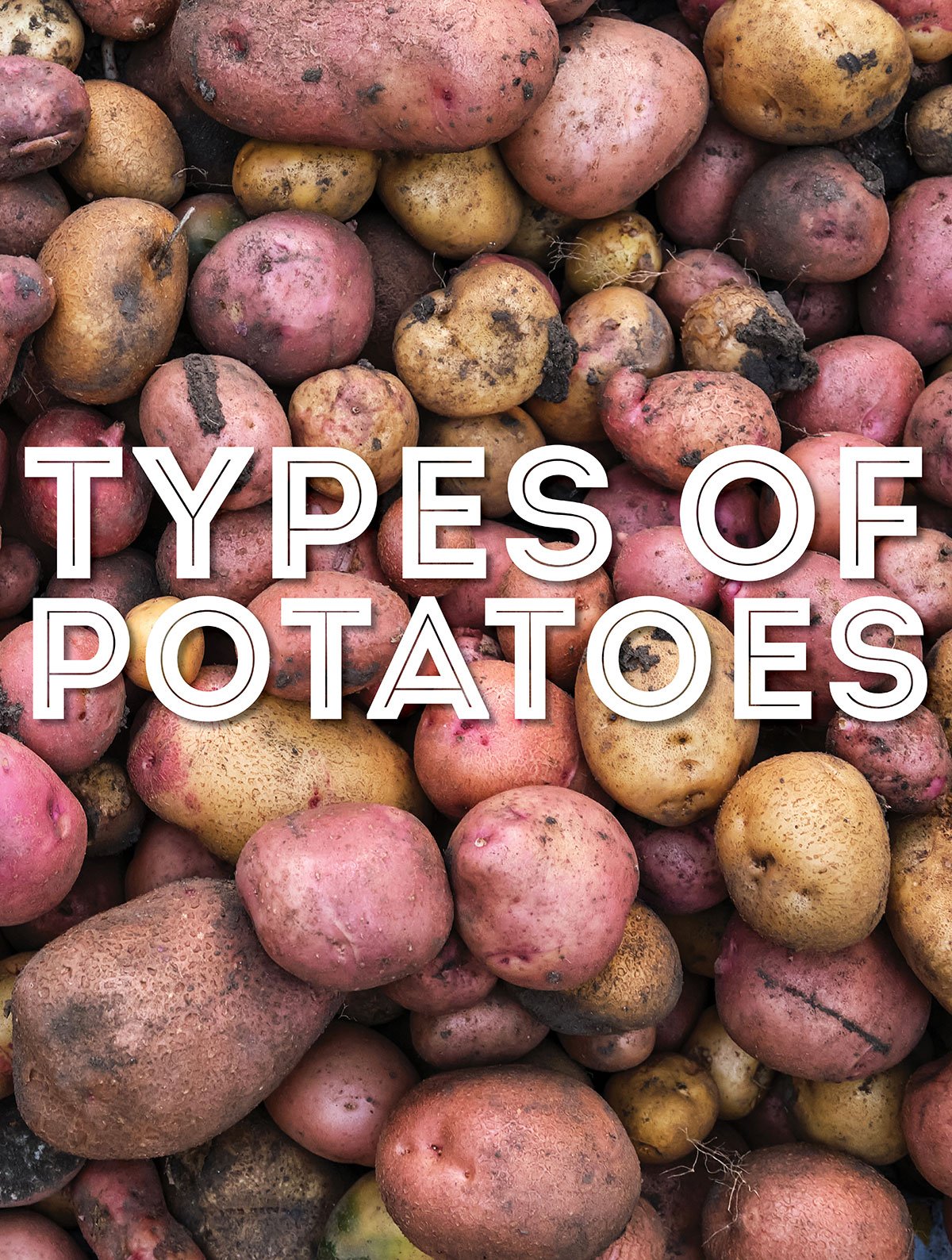
Americans eat over 110 pounds of potatoes a year, but the humble potato has been a world-wide staple for thousands of years. Potatoes are indigenous to the Andes Mountains of Peru, and came to Europe through early Spanish explorers. They are currently the fifth most important crop in the world.
We aren’t sure what color ribbon 5th place gets, but the immigration of the Irish to America in the 19th century speaks to their historical and worldwide importance, A blight on the Irish potato crop resulted in what is called the “Irish Potato Famine”of 1847. During the famine, tens of thousands of Irish, in sheer desperation, left their ancestral home for America.
There are over 200 potato varieties world-wide. We won’t try to cover all the different types of potatoes as some are pretty obscure. While you may only be familiar with the standard supermarket varieties, there are quite a few regional favorites and obscure spuds out there. It can be hard to know which to choose when cooking one of the countless recipes that employ the tuber. So let’s walk through some of the most common varieties of potatoes!
Potato Trivia
This original Mr. Potato head was missing one body part. Do you know what it was? Answer at the bottom of this post!
Types of Potatoes
When cooking be sure to choose the right potato for the recipe. Each variety of potato has its own qualities that make it better for some cooking methods and not as ideal for others. There are three classes of potatoes: starchy, waxy, and all-purpose.
Starchy potatoes, having more starch, tend to be dry, fluffy, and absorbent (hello butter!) These qualities make them great for baking or frying. The dry flesh makes them crumble easily and thus ideal as baked potatoes. The starch also absorbs oil making them great for frying. Starchy varieties are also best for french fries because the interior of the fries stays fluffy during cooking while the exterior becomes crispy.
Waxy potatoes have very little starch and a moist flesh. The cells in the flesh of these potatoes stay bonded together when cooked which means that slices and chunks cut from them stay together nicely when boiled or cooked. Waxy potatoes generally have a thinner skin, hold their shape well, and don’t crumble when cooked like their starchy cousins. They are your best bet for use in soups, salads, casseroles, and layered dishes like scalloped potatoes. Can you bake a waxy potato? Sure, but it won’t have the ideal texture or absorb toppings as well.
All-purpose potatoes are the third type. You could say they aren’t ideal as either starchy or waxy for specific uses, but if your glass is half-full, you can say they are great for all purposes. They are still fluffy as mashed potatoes, but hold their shape well enough when boiled, roasted, or fried. These are great potatoes to keep in the pantry if you aren’t sure what kind of cooking you might do with them.
This guide will shine a light on some of the most common types of potatoes and ways to use them. Looking for more on how to select, cut and store potatoes as well as nutrition info? Check out our Potatoes 101. We will include some types of sweet potatoes in our list as they are related, but also very different. While both originated in Southern Peru (not Ireland!), their nutrient compositions are very different.
- All Blue Potatoes
- Austrian Crescent Potatoes
- Beauregard Sweet Potato
- Bintje Potatoes
- Desiree Potatoes
- French Fingerling Potatoes
- German Butterball Potatoes
- Hannah Sweet Potato
- Japanese Sweet Potatoes
- Jewel Yams
- Kennebec Potatoes
- Kerr’s Pink Potatoes
- La Ratte Potatoes
- New Potatoes
- Norland Potatoes
- Phureja Potatoes
- Purple Majesty Potatoes
- Purple Peruvian Potatoes
- Ranger Russet Potatoes
- Red Bliss Potatoes
- Red Gold Potatoes
- Red Thumb Potatoes
- Russet Burbank Potatoes
- Russet Norkotah Potatoes
- Russian Banana Potatoes
- Stokes Purple Potatoes
- Umatilla Russet Potatoes
- Vitelotte Potatoes
- Yukon Gold Potatoes
All Blue Potatoes
All Blue Potatoes are, as their name suggests, blue inside and out. They are an all-purpose potato but tend toward the starchy side and are thus recognized as good for baking, and if you want to be sure to keep their unique color boil or bake them. The advantage to boiling is the water will turn blue and have some value as a mild dye for Easter eggs or cloth. Like other blue fruits and vegetables, the all-blue potato contains the antioxidant anthocyanin giving them a distinct nutritional boost.
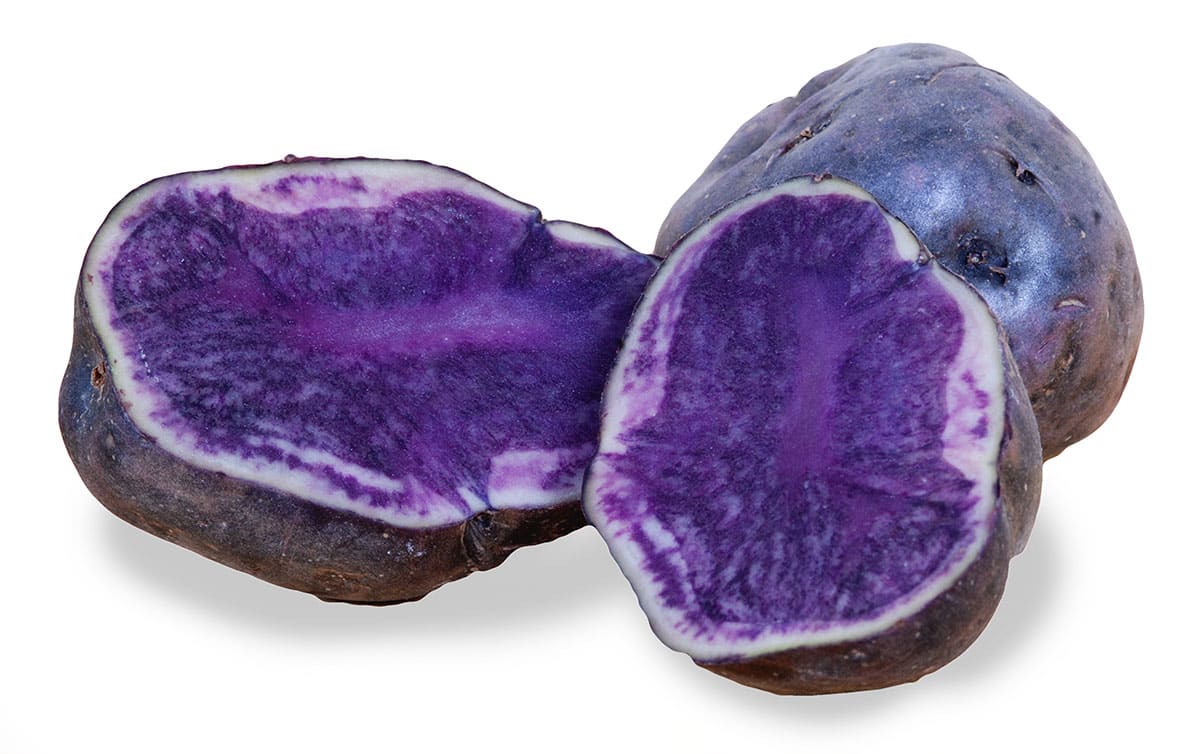
Austrian Crescent Potatoes
The Austrian Crescent is a waxy crescent shaped fingerling potato that may have originated in Austria. Whether they did or not, they are particularly popular in Austria, Germany, and the Czech Republic and widely grown in all three. In Germany they are called the Kipfel which simply means croissant. Again, an obvious nod to their shape. They are light-yellow inside with a smooth tan skin, and are often used in potato salads, steamed, roasted, or boiled. Try them in this Rosemary Roasted Potatoes!
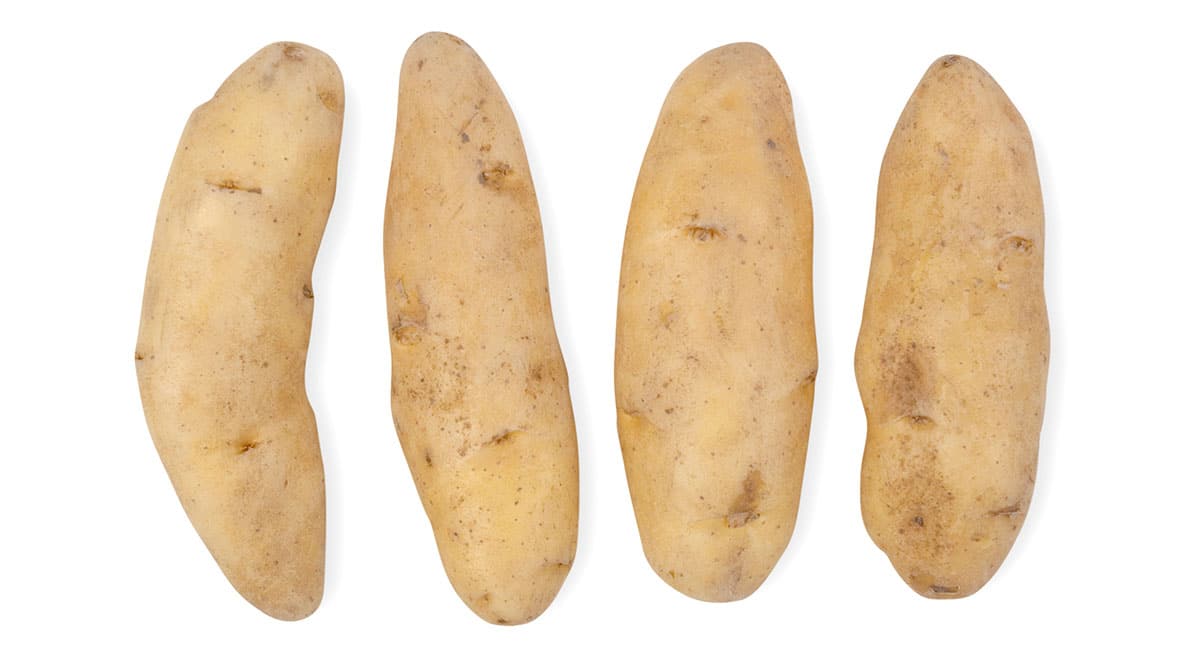
Beauregard Sweet Potato
The Beauregard is a fairly recent sweet potato variety that came out of the Louisiana Agricultural Experiment Station in 1987. Sweet potatoes are generally starchy, but this large sweet potato with bright orange flesh is less so than some others and is said to be almost creamy. For ideas on how to use your favorite sweet potato checkout 13 Easy Ways to Cook With Sweet Potatoes.
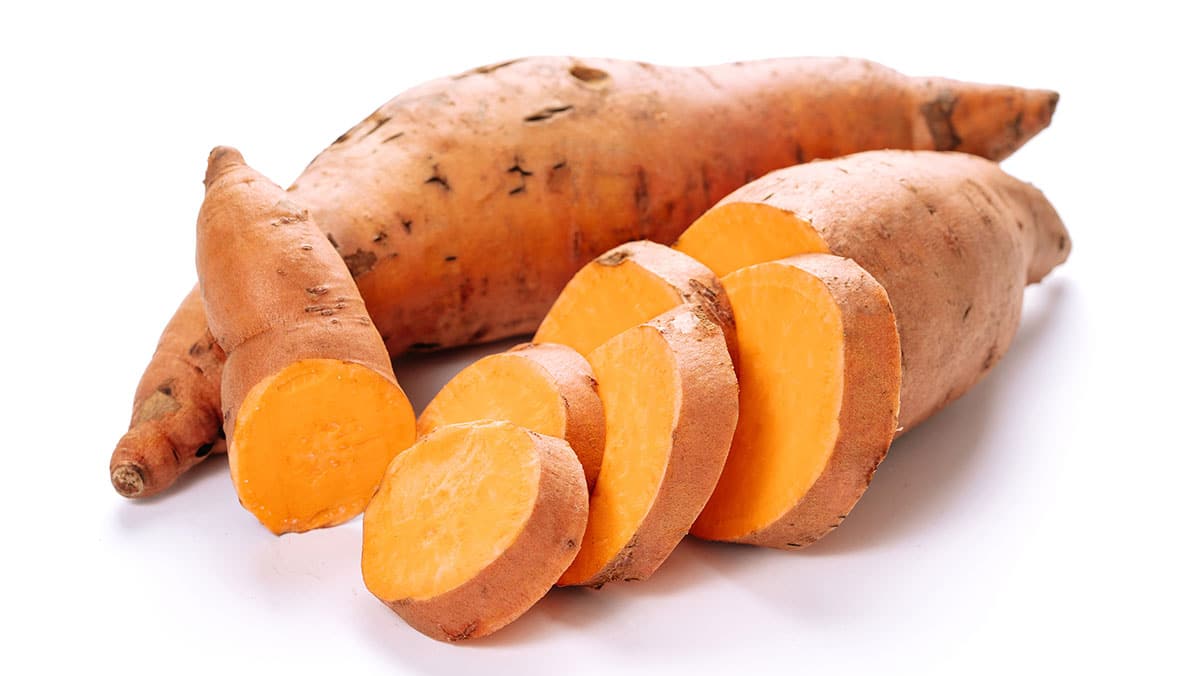
Bintje Potatoes
Bintje are a waxy potato developed in the Netherlands in 1905, but they quickly grew in popularity as they are today the most heavily grown yellow potato in much of Europe. They are used in Europe to make pommes frites (French Fries), so that would be their super power despite being a waxy variety. If that has you thinking about some homemade fries, crank up your air fryer and give make these Air Fryer Potatoes.
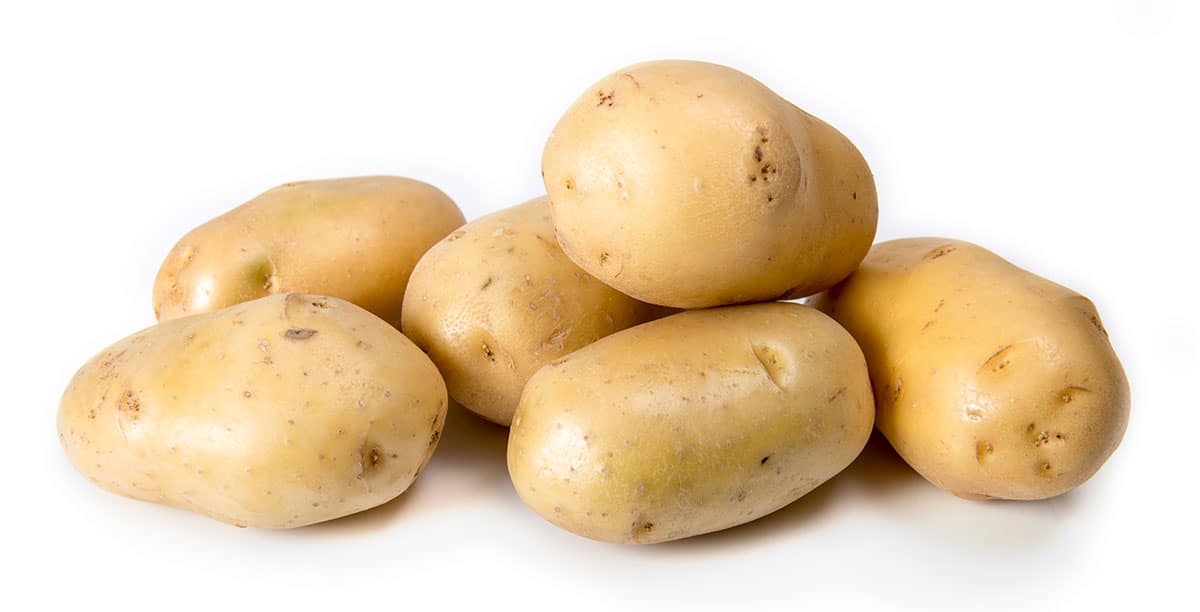
Desiree Potatoes
The Desiree Potato came from the Netherlands where it was developed in 1962. It is an all-purpose potato on the waxy side with yellow flesh and a pink to red skin. Desirees hold their shape well and are good in all sorts of cooking to include roasting, mashing, in salads, wedges, or chips.
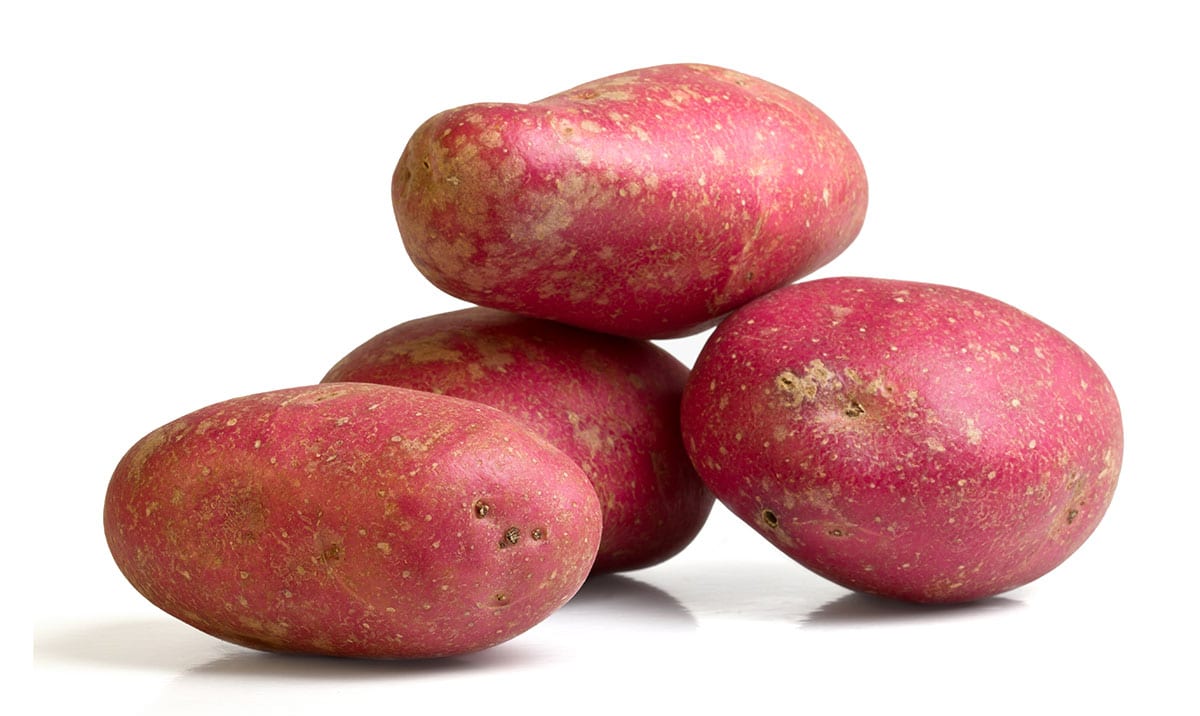
French Fingerling Potatoes
French fingerlings were originally called Roseval potatoes when they were developed by the French national Federation of Producers of Potato Plants in the 1950s and introduced to America via the University of Florida. These smaller sized waxy spuds have a long cylindrical shape as is common in fingerlings. Their rose colored skin conceals a white flesh that can have traces of pink marbling. These potatoes have a buttery texture and are often boiled or roasted. Use this variety in any recipe calling for fingerlings. A great recipe for any such waxy potato is this Potato Curry Recipe.
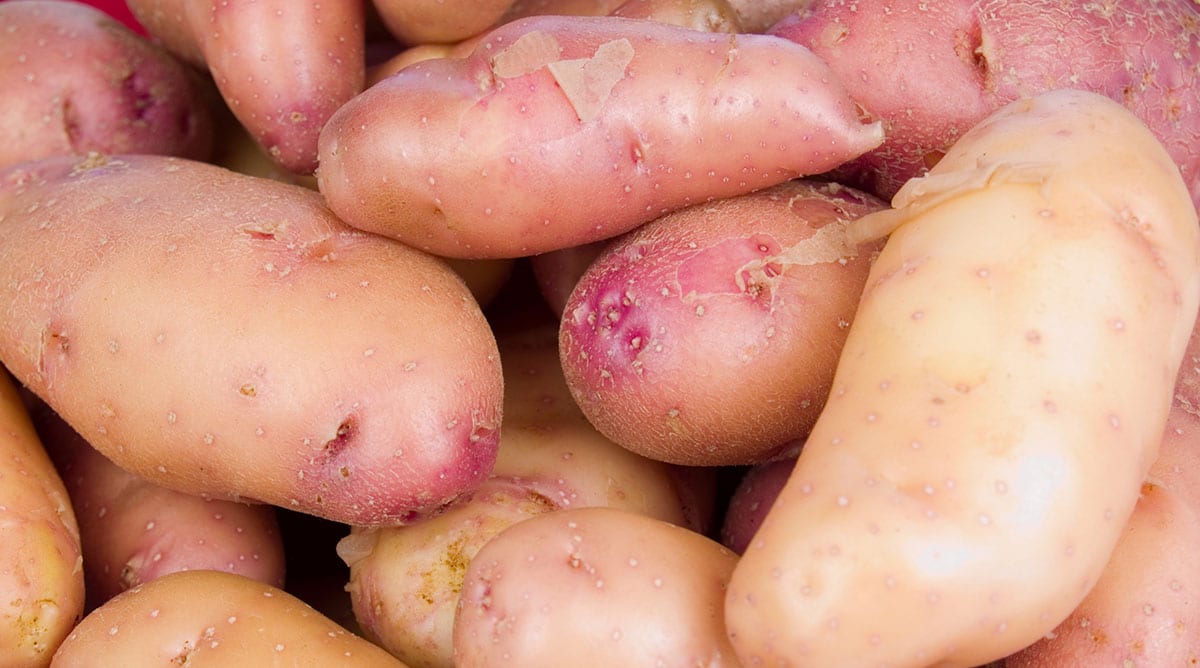
German Butterball Potatoes
The German Butterball Potato came out of Idaho in 1988. It is a medium to large round all-purpose potato with a yellow skin and waxy yellow flesh. This is a tender buttery potato when baked, and is also good fried, mashed, or really in any form of preparation.
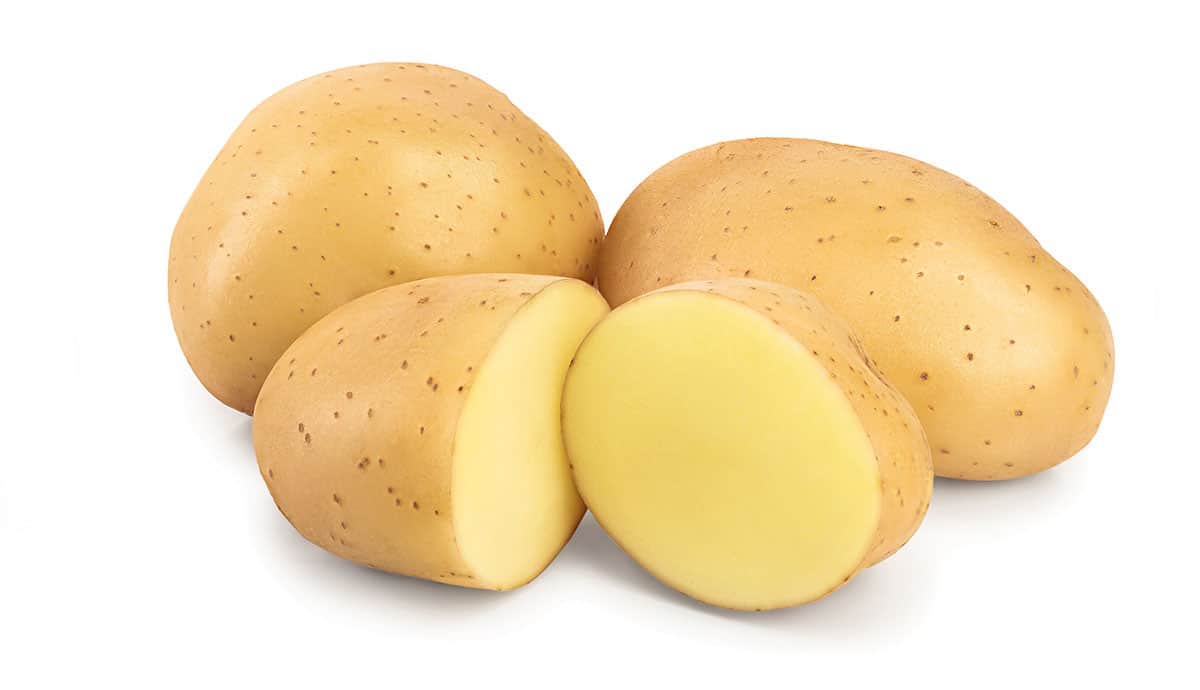
Hannah Sweet Potato
The Hannah are typically used in savory sweet potato recipes as they aren’t as sweet as other sweet potato varieties. Their skin is tan and the flesh cream colored when raw, but cooks to a more yellow color. This is an all-purpose variety more similar to white potatoes in that regard than other sweet potatoes. They hold their shape better than other sweet potatoes, and can be used in soups, stews, baking, deep frying, roasting, etc. All the advantages of an all-purpose spud. Try them in these Oven Baked Sweet Potato Wedges.
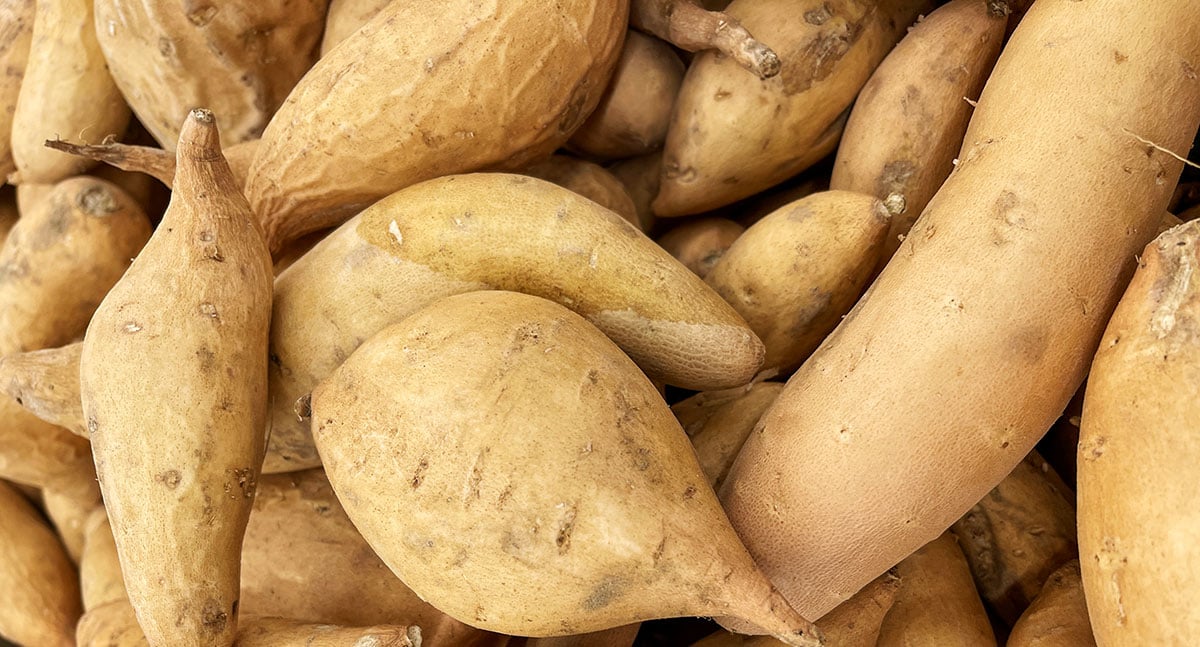
Japanese Sweet Potatoes
Japanese sweet potatoes originated in China, but came to Japan through the Island of Okinawa in the early 17th Century. These starchy potatoes have a red skin and yellow flesh differentiating them from most American sweet potato varieties. They are quite starchy making them ideal for baking, mashing, and deep frying. Sweet potato fries are an obvious good use as the Japanese sweet potato crisps up when fried, but stays soft in the middle. They are popular in Japan where they are made into a snack sold by street vendors. These are perhaps the sweetest among sweet potato varieties, and are great in Thanksgiving dessert recipes though their yellow flesh doesn’t give the traditional bright orange sweet potato casserole look. Give them a try in Sweet Potato Smashers!
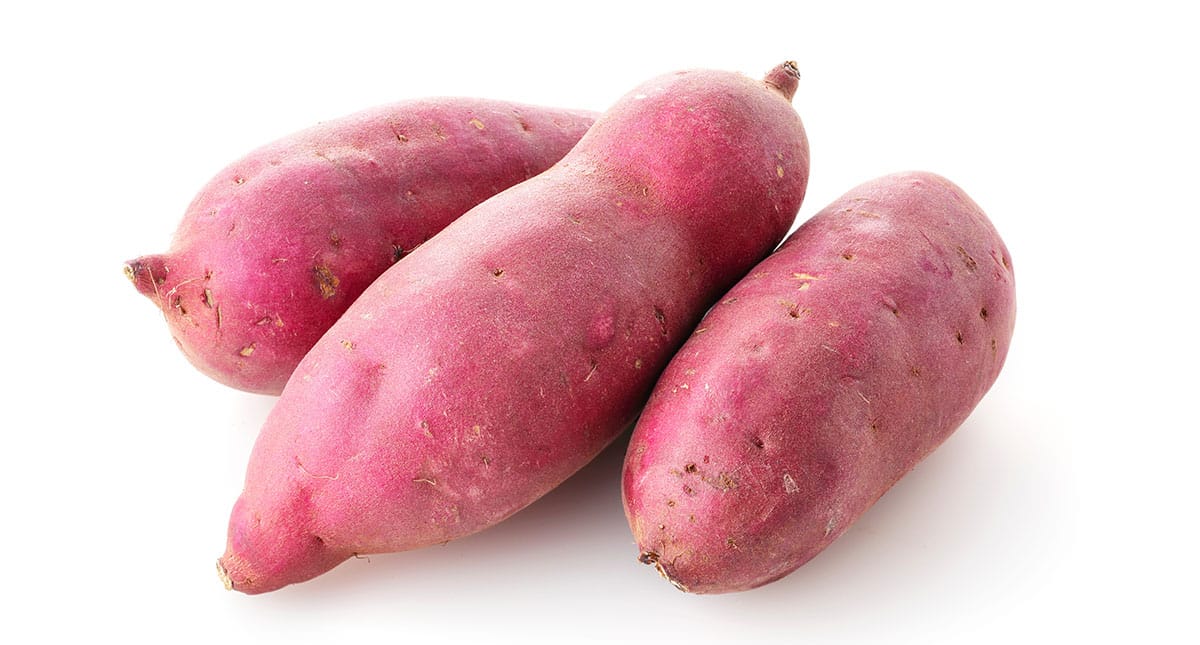
Jewel Yams
Jewel Yams were developed in the United Stated in the mid-20th Century. They have a pleasing orange flesh and red to copper skin. They are in fact sweet potatoes, not yams, and are ideal for dessert recipes. Like Most sweet potatoes they are starchy and good in baking and mashing, and of course our favorite sweet potato fries. Try them in this Sweet Potato Casserole.
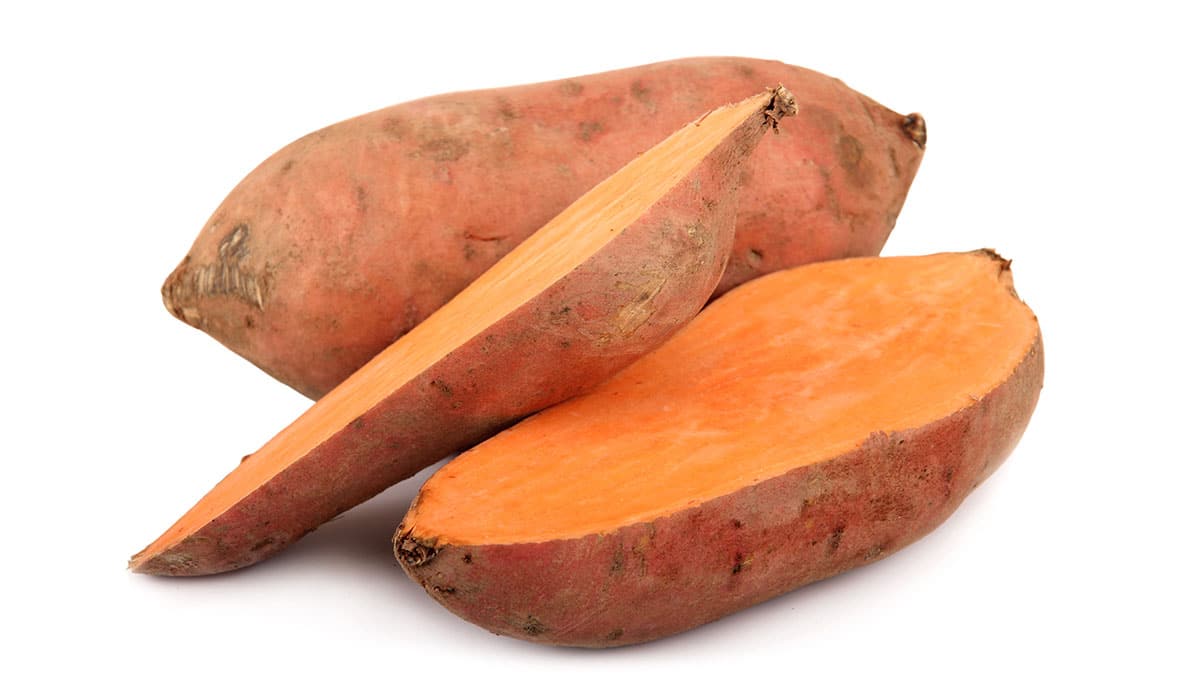
Kennebec Potatoes
Kennebec Potatoes are large all-purpose potatoes with tan skins and white flesh. Pretty much the stereotypical spud which was the intent when they were developed by the Presque Isle Station in Maine in conjunction with the USDA in 1941. These potatoes are great fried, be that as French fries, chips, hash browns, you name it. They are currently used in most of the US potato chip varieties as well as the french fries at In N Out Burger, though they haven’t pulled McDonalds away from the Russett.
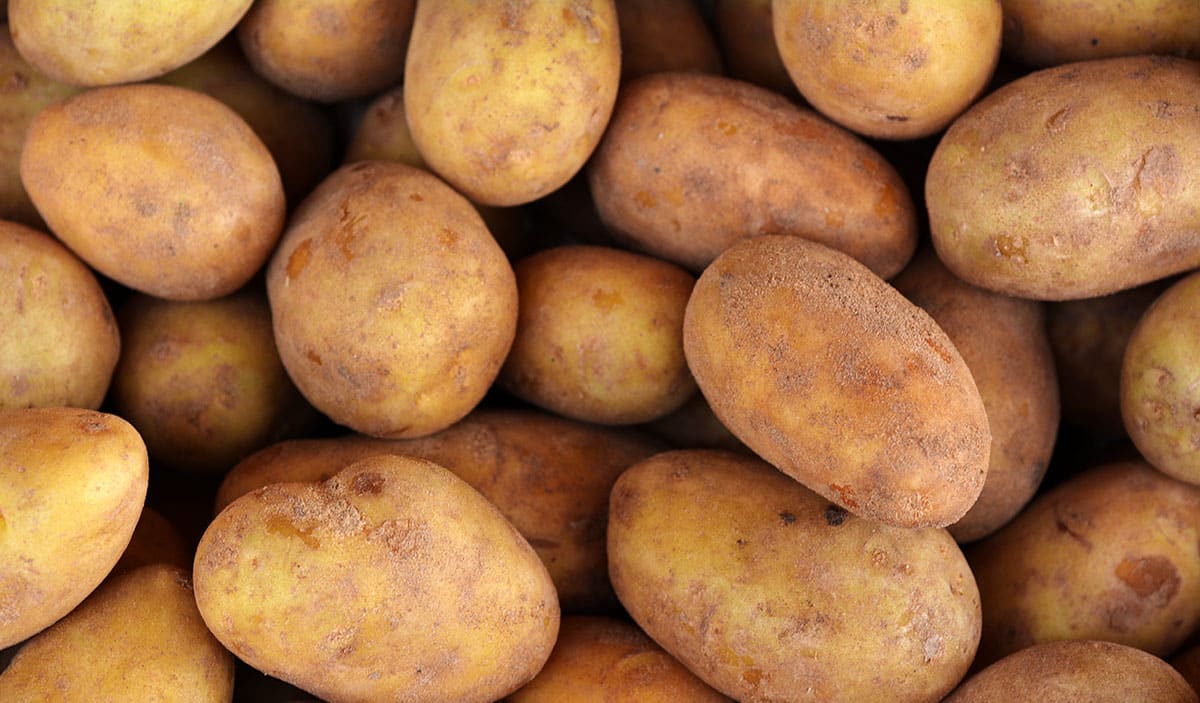
Kerr’s Pink Potatoes
Kerr’s Pink are often called the Irish Potato as they were introduced in Ireland in 1917 though they were developed by a Mr. Henry Kerr in Scotland in 1907. These somewhat starchy spuds are still widely popular in Ireland accounting for 25% of the crop there. They are a pink skinned starchy spud great mashed or boiled, but also often used in chips as they are considered an all-purpose potato in Ireland.
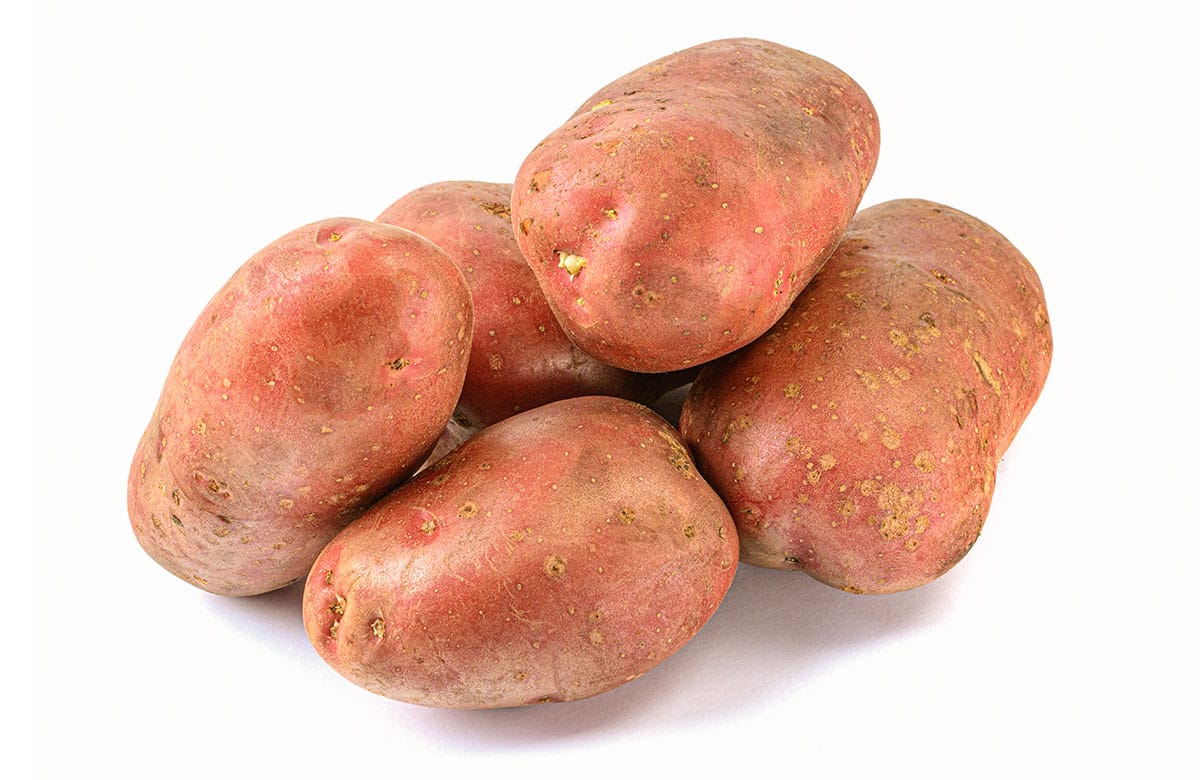
La Ratte Potatoes
The La Ratte is a small waxy fingerling potato with a buttery texture and a mildly nuttly flavor. These French potatoes have an aesthetic yellow flesh, and bumpy oblong shape. The la Ratte was developed in France sometime in the 19th Century, but fell out of favor in the 20th. They have made a comeback in the last 50 years as a specialty potato. In the USA they are grown in the Pacific NW. Try these waxy gems in Potato Leek Soup.
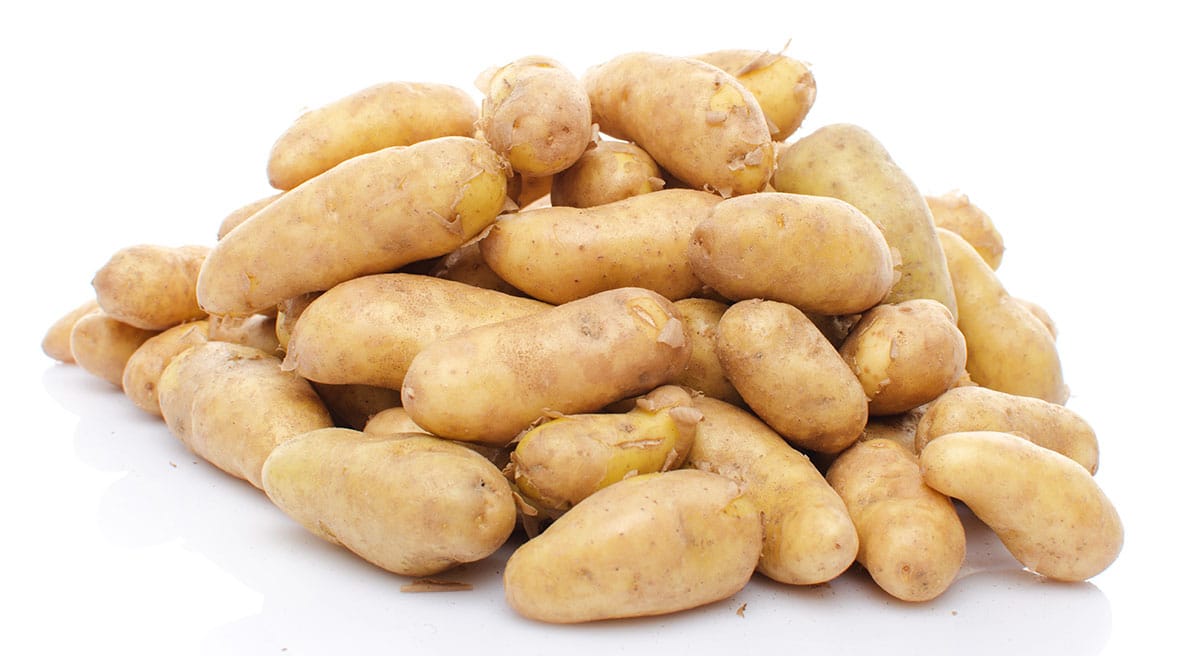
New Potatoes
Okay, we are kind of cheating here. New Potatoes is not a distinct potato variety, but a term used to refer to potatoes harvested early in the season. New potatoes have very thin skins and a moist waxy flesh. So in the spring and early summer, buy fresh new potatoes and use them as you would in any of your favorite recipes that call for a waxy potato like roasting in the skin, boiling, steaming, or in salads. Try any variety of new potatoes in this Vegetable Biryani.
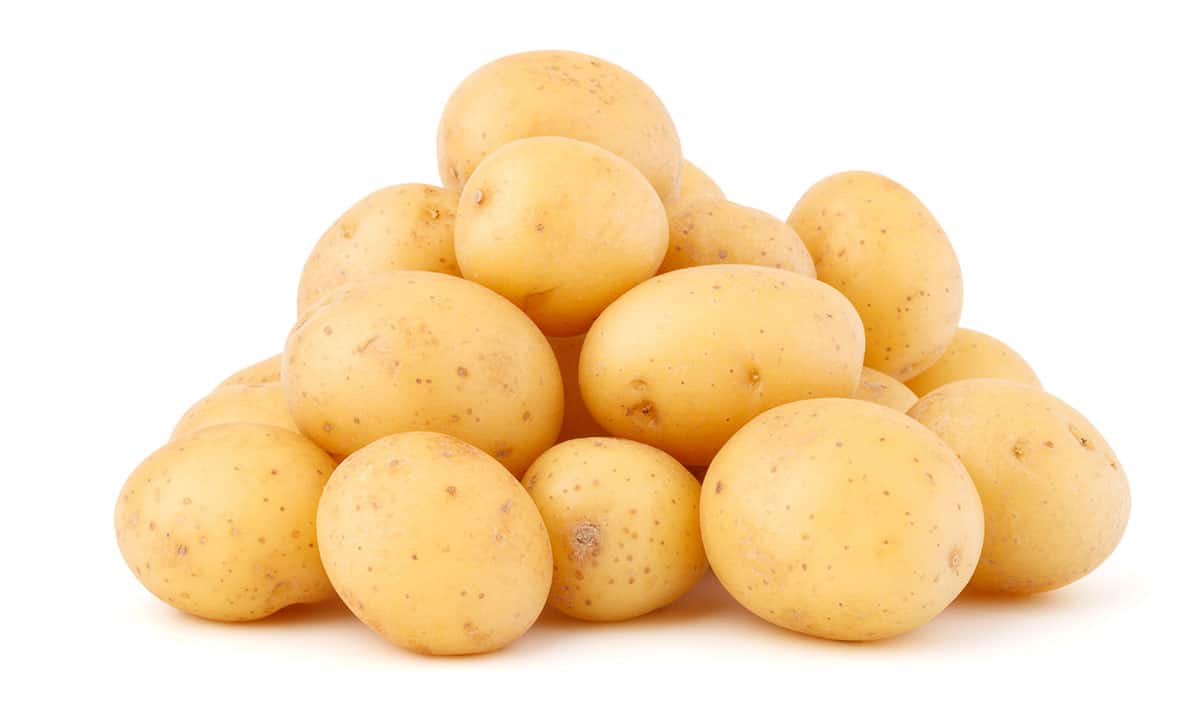
Norland Potatoes
Norland Potatoes are the 6th most produced potato in the United States constituting 3% of all production. They were developed by the North Dakota State University in 1957, and were then followed by new varieties like the Red Norland and Dark Red Norland. The Dark Red quickly became one of the best-selling red potato varieties in the US. They are an all-purpose potato that can be used in most recipes. Try them in these Smashed Red Potatoes!
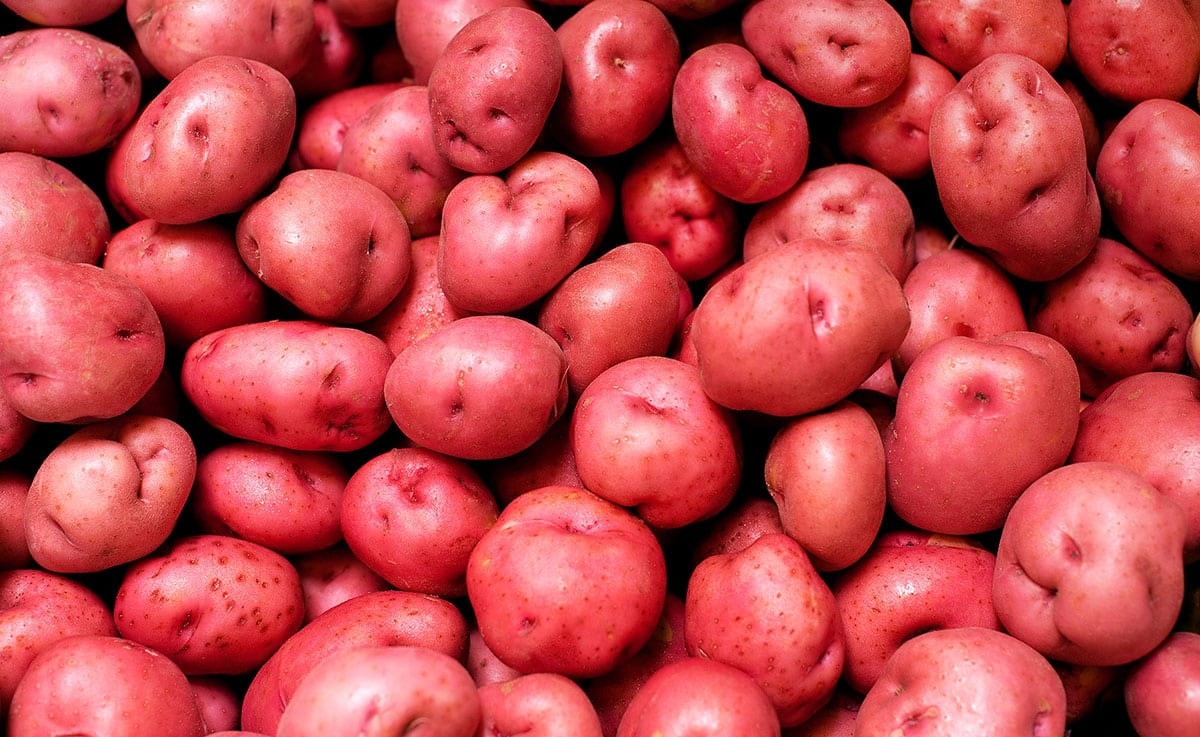
Phureja Potatoes
Phureja have been grown, we think, for thousands of years and are native to the Andean Mountains of South America. They are a waxy potato with a smooth texture. They are generally red, but can also be lighter skinned. They have an interesting advantage in that they cook much more quickly than other varieties. Use them as you would other waxy potatoes in soups, salads, boiled, etc.
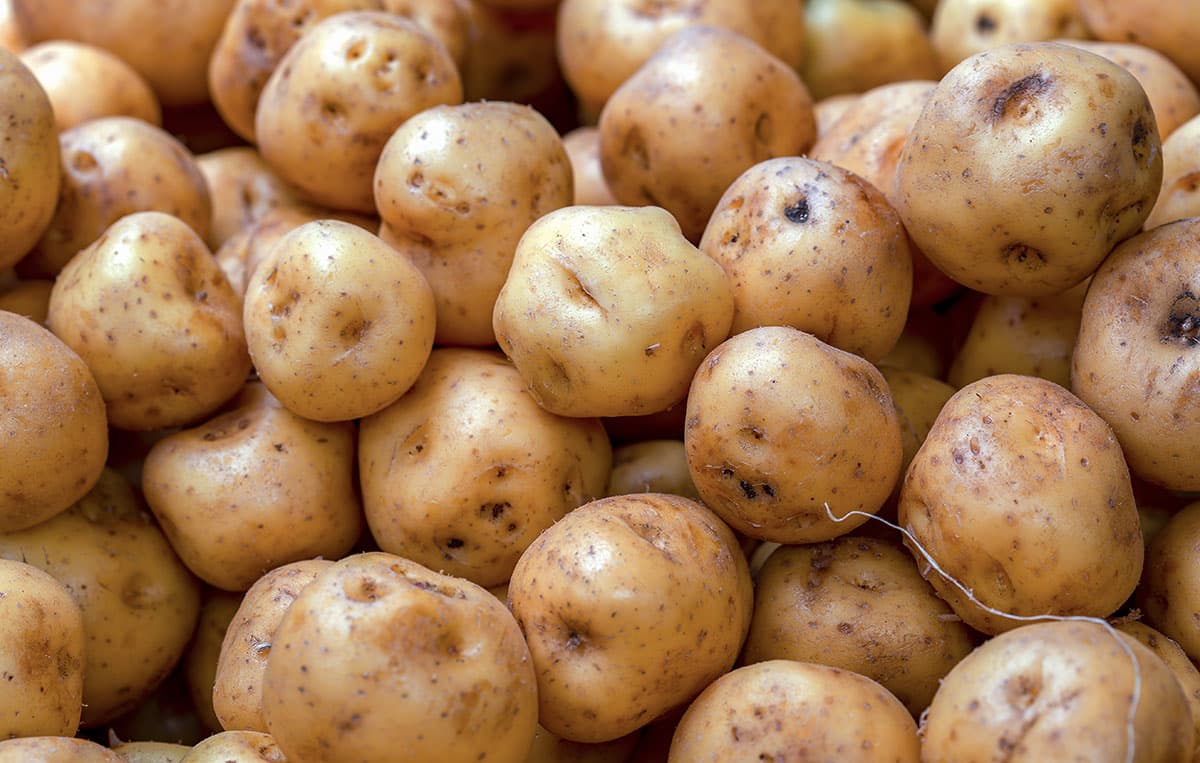
Purple Majesty Potatoes
Purple majesty potatoes have an unusual, let’s go with aesthetic, dark purple skin and flesh. They are considered an All-purpose potato. Use these in any recipe that you want to leverage that wonderful color. They were developed at the Colorado State University not just to be stunning, but multi-use like the best all-purpose potatoes. The drawback to these spuds is that they are known to not last as long in your pantry, so keep any eye on them.
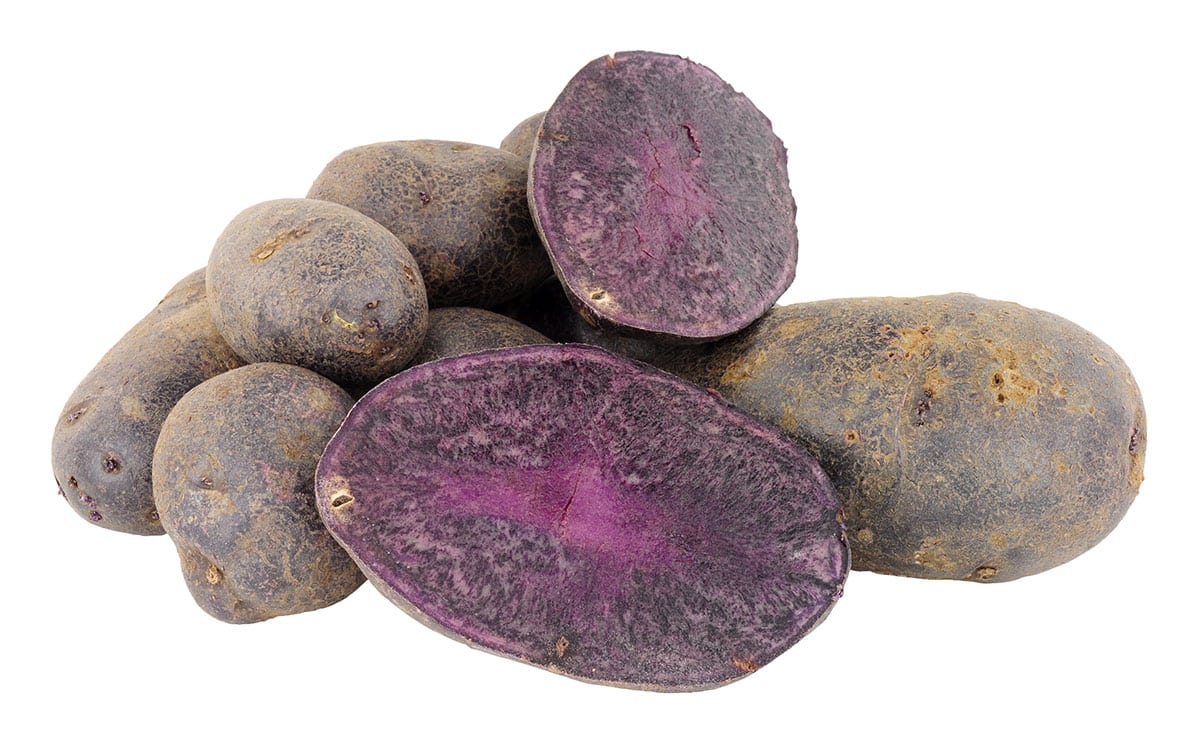
Purple Peruvian Potatoes
These are a starchy fingerling variety. They have a purple skin and blue flesh with the customary slim fingerling shape. Most fingerlings are actually waxy, but not the Peruvian which are great mashed, baked, fried, or in chips. Use these when you want a starchy potato (baked, mashed, fried), but with the unique blue presentation.
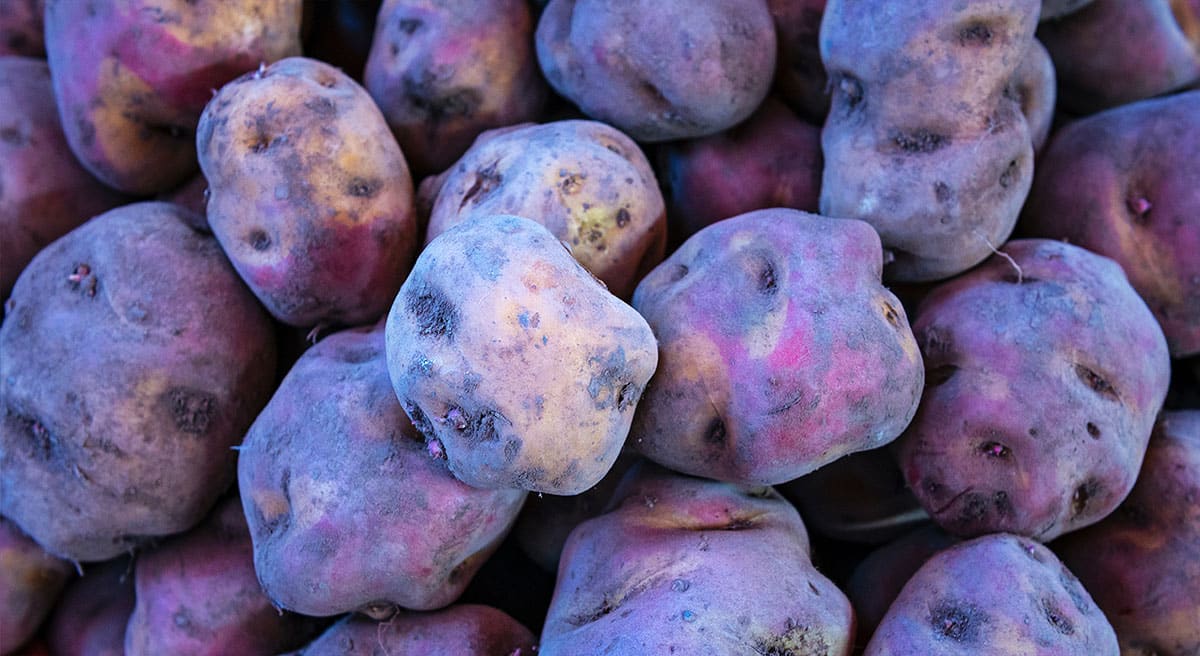
Ranger Russet Potatoes
The Ranger Russet is America’s #3 most grown potato constituting 9% of national production. While you don’t get a big foam number one finger for this, it is still pretty impressive. They are tan to brown skinned starchy potatoes. Russets are in general large brown potatoes ideal for baking or mashed after peeling. The flesh is light and fluffy when baked and absorbs all the butter or sour cream you want to add. Russets are ideal for french fries as they are a larger spud that can be cut into long fries. After french fries our favorite use of an eminently mashable potato is in Vegetarian Shepards Pie.
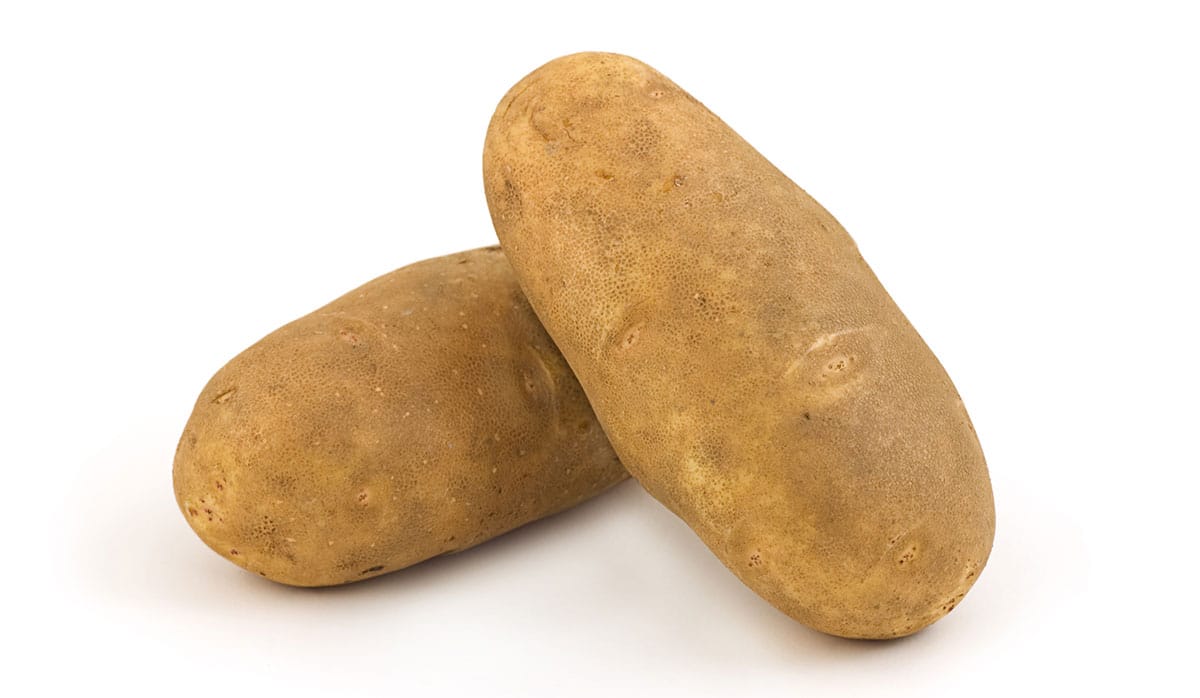
Red Bliss Potatoes
Red Bliss have a dark red skin, but white flesh. They are a waxy spud with a low starch content that boil well, and are often used in potato salads. Their moist flesh (typical for waxy potatoes) allows them to keep their shape well when cooked. These are a bit of a culinary oddity in that they are often mashed (unpeeled) despite their low starch and high moisture content. Many growers harvest them young as new potatoes.
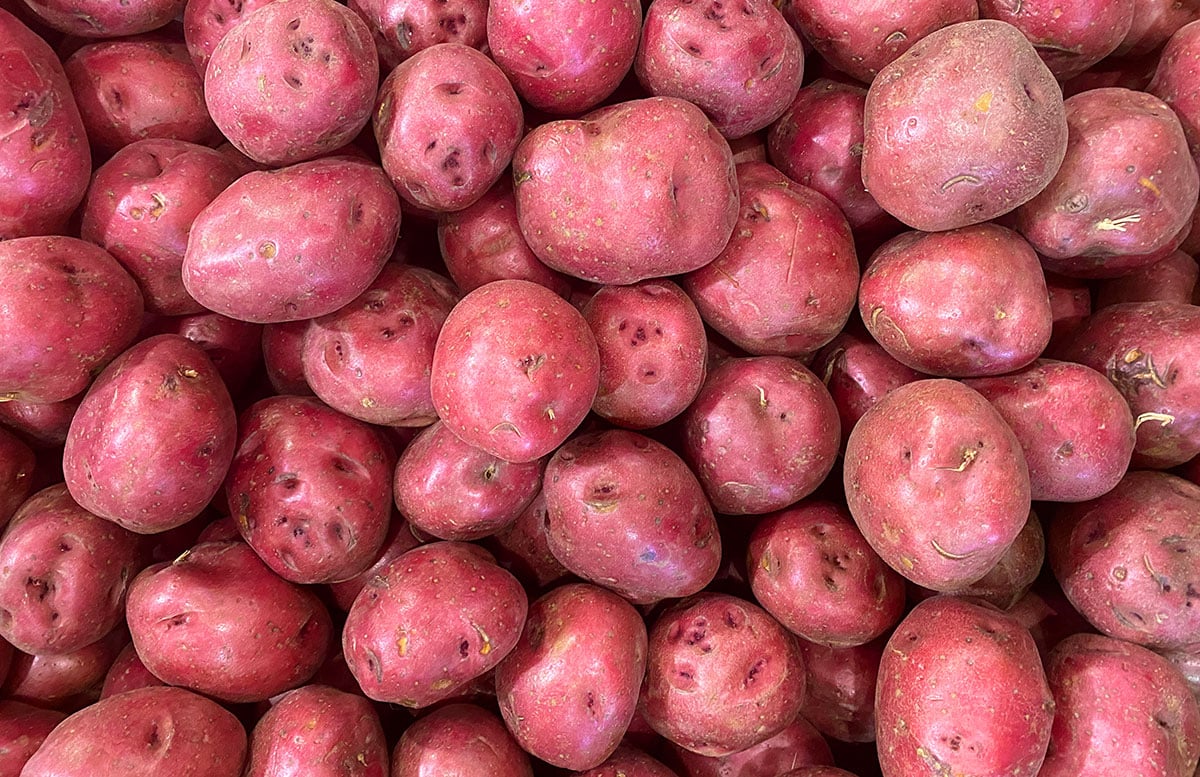
Red Gold Potatoes
The Red gold is an all-purpose potato developed in Canada in the 1970s. They are medium-sized potatoes with tan or red skin and golden flesh.They are commonly baked, boiled, roasted, or mashed.
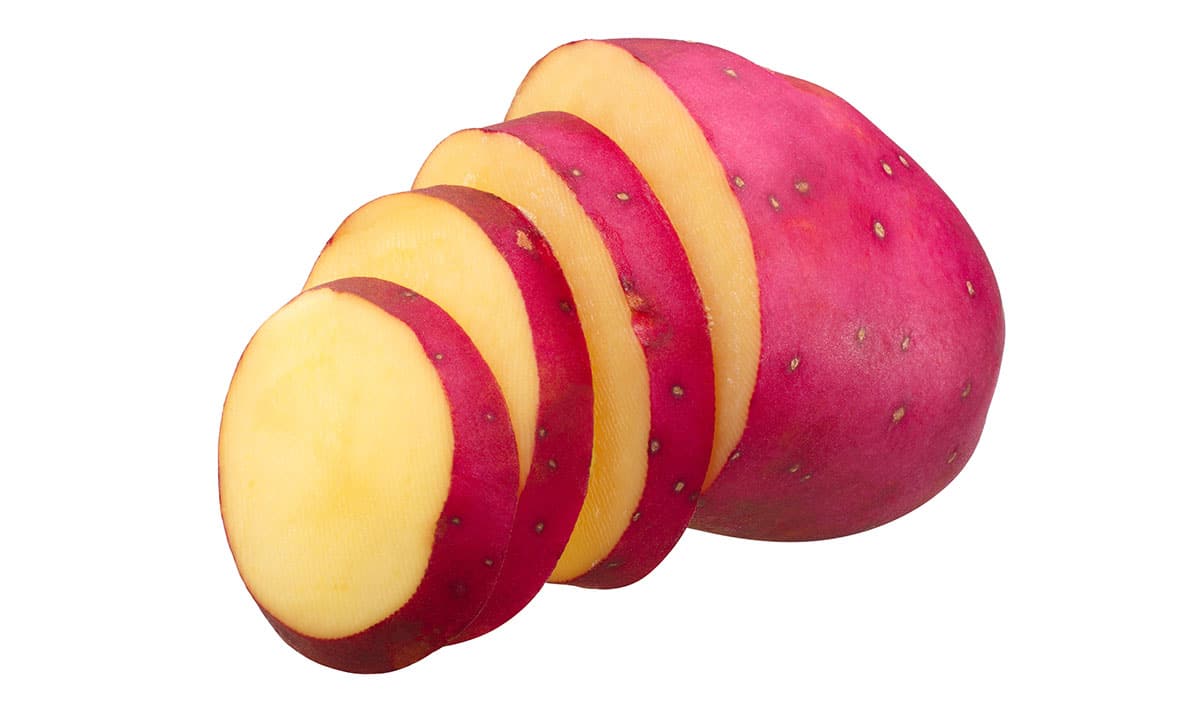
Red Thumb Potatoes
Red thumb is a fingerling potato with a red skin and pink flesh. They are generally said to be sweeter than Russian Banana fingerlings and having less starch than their Russian cousin. They have a creamy texture and buttery flavor typical of waxy potatoes. Use them in any recipe calling for a fingerling potato. Their pink/white marbled flesh would add a nice accent to potato salad. As a waxy potato they will also hold their shape well cooked and served as a side.
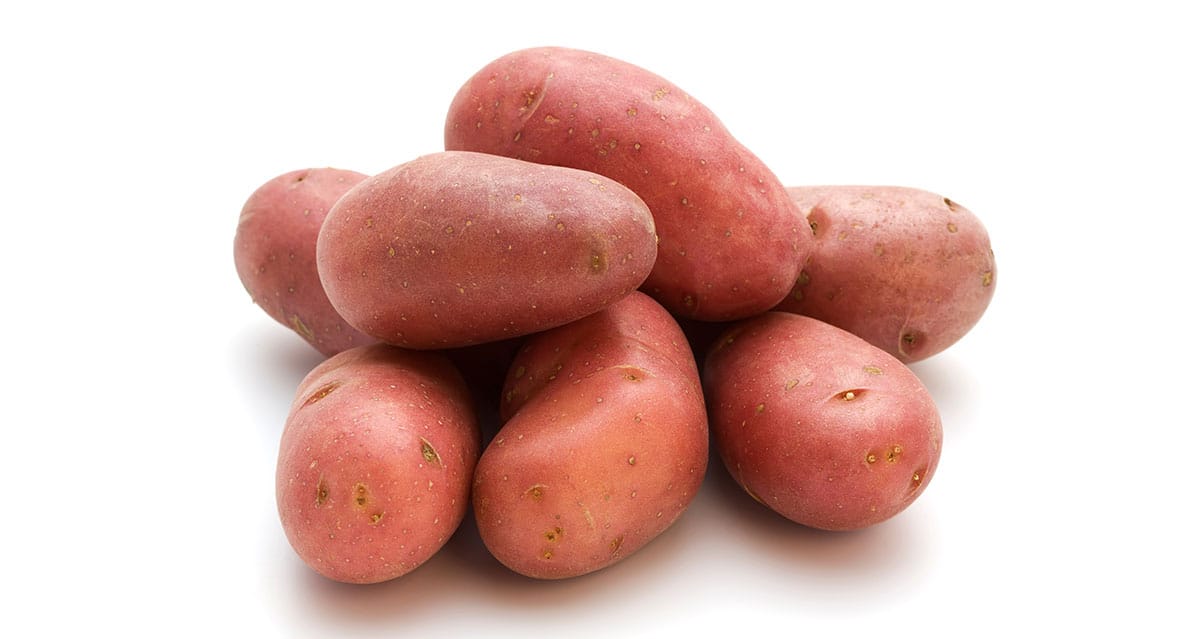
Russet Burbank Potatoes
This is America’s most grown potato making up 41% of the national crop and 90% of the crop in Idaho where they were developed in 1851. This potato took a while to catch on in America, but the invention of frozen french fries was its spark. These large starchy potatoes became the go to potato for making french fries in the 1950s, and are today the variety used by McDonald’s. They are quite starchy with a low moisture content which also makes them one of the best baking or mashing potatoes. While we can’t tell you how to make McDonald’s fries, you might like russets in your air fryer.
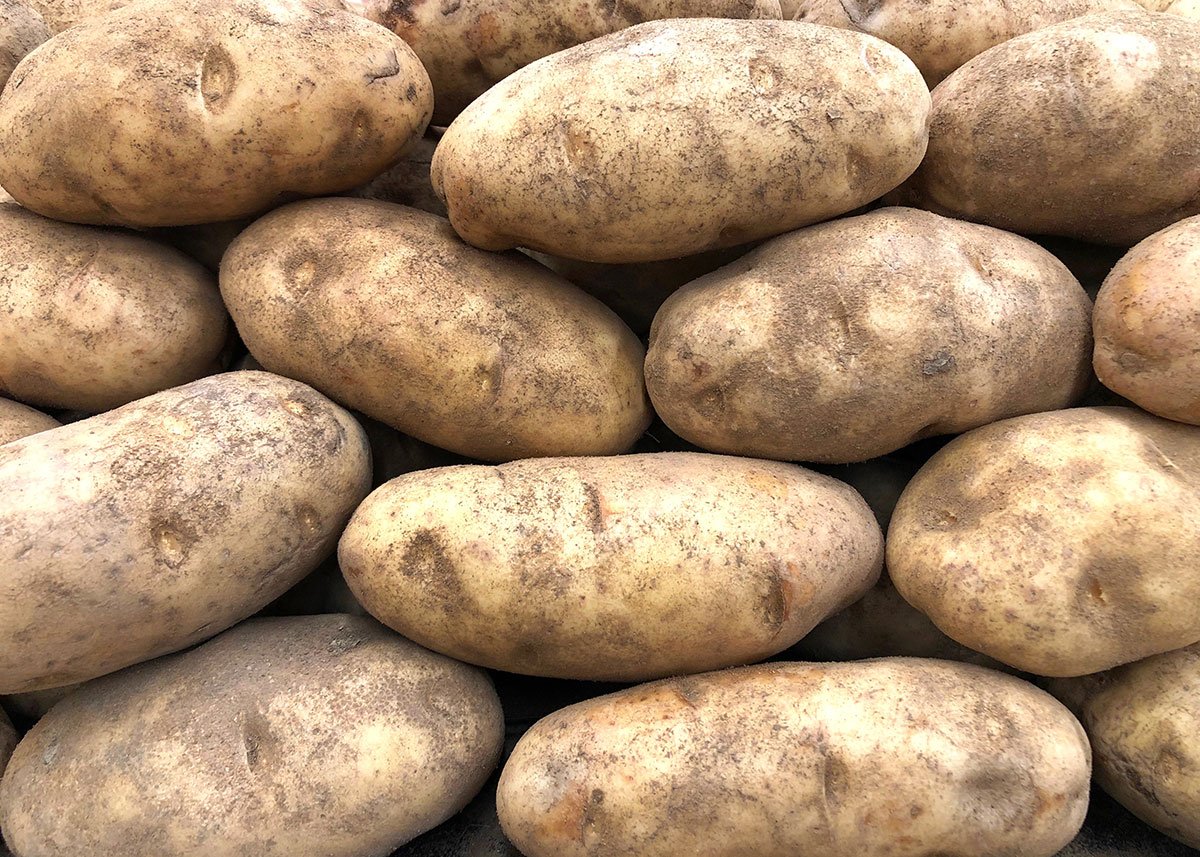
Russet Norkotah Potatoes
This is America’s #2 potato at 12% of national production. They were developed in North Dakota in 1987. Like other Russets, they are a starchy potato used mostly for french fries and baked potatoes. Not in the mood for a baked potato? Try this Mexican Potato Skins Recipe.
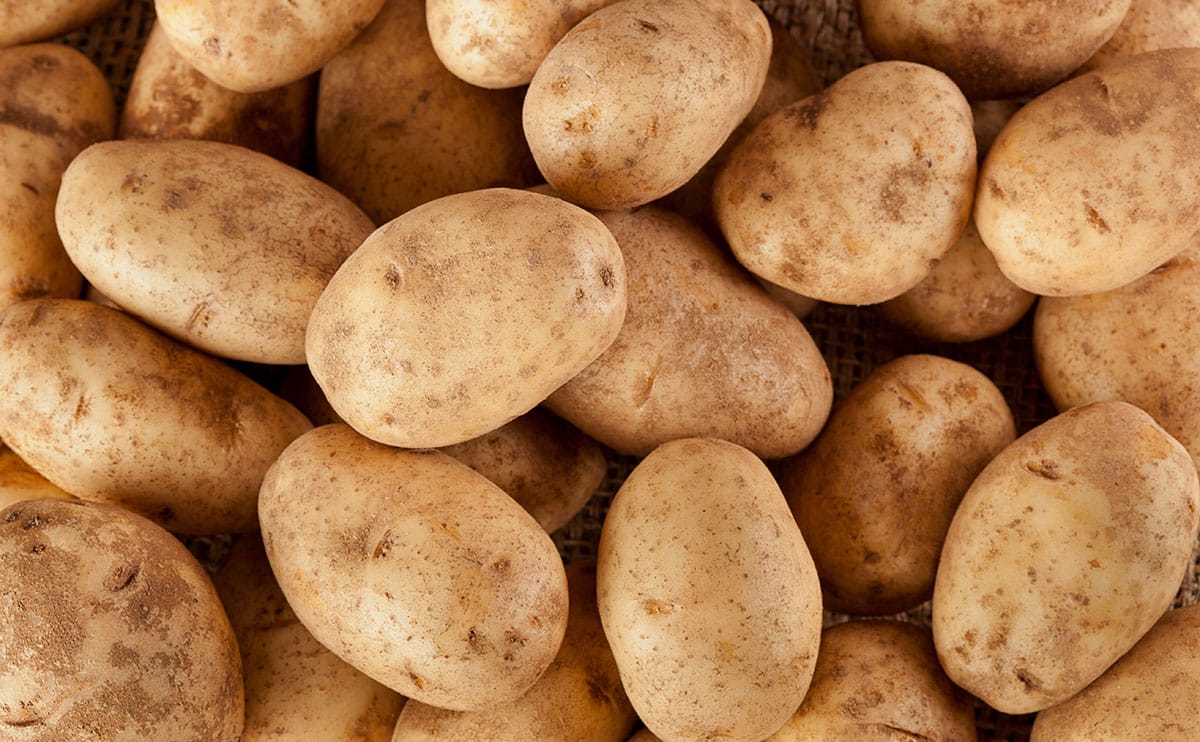
Russian Banana Potatoes
These are smaller fingerlings that get their banana name from their curved shape and yellow flesh. The Russian part comes from their origin in the Baltics sometime around the 18th Century. These are a waxy fingerling known for their sweet buttery flavor. They are good for grilling, boiling, and roasting.
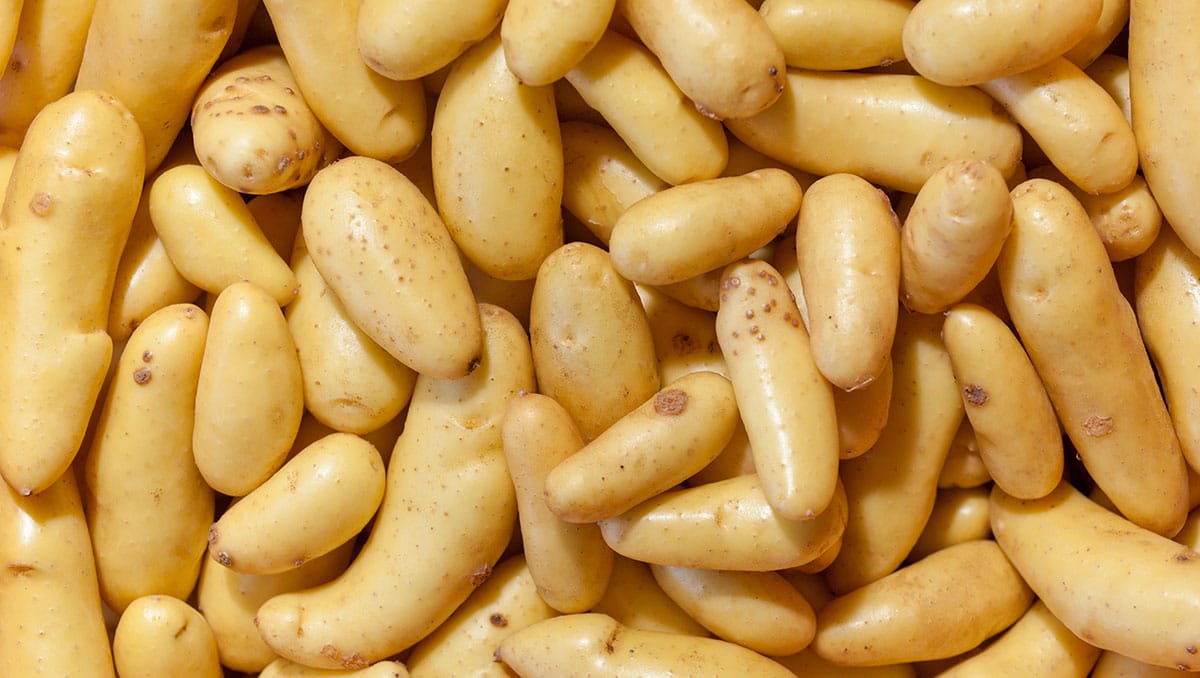
Stokes Purple Potatoes
The Stokes Purple is a sweet potato with brown-purple skin and purple flesh. They were developed in Stokes County NC giving them their name. The Stokes is not as sweet as its orange fleshed cousins, but is an all-purpose moderately starchy and moist variety. They are good roasted, steamed, or baked and of course their purple color is unusual for a sweet potato. If you want to leverage the purple flesh for an unusual and decadent treat, use them in this Sweet Potato Smoothie recipe.
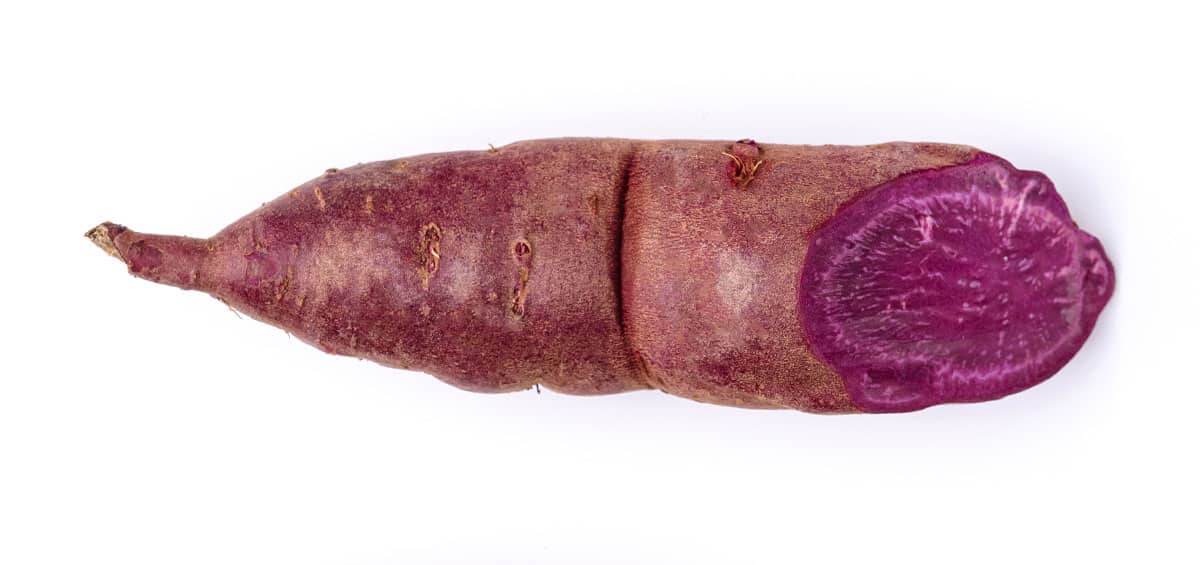
Umatilla Russet Potatoes
This is the #4 most grown potato in the USA accounting for 7% of production. You may have noted that all the top American potatoes are Russet varieties. As starchy potatoes they are just ideal for two of America’s favorite potato cooking methods: baked and as french fries. The Umatilla was developed by the US Department of Agriculture and the Agricultural Experiment Station (a joint Oregon, Idaho & Washington State organization) in 1998.
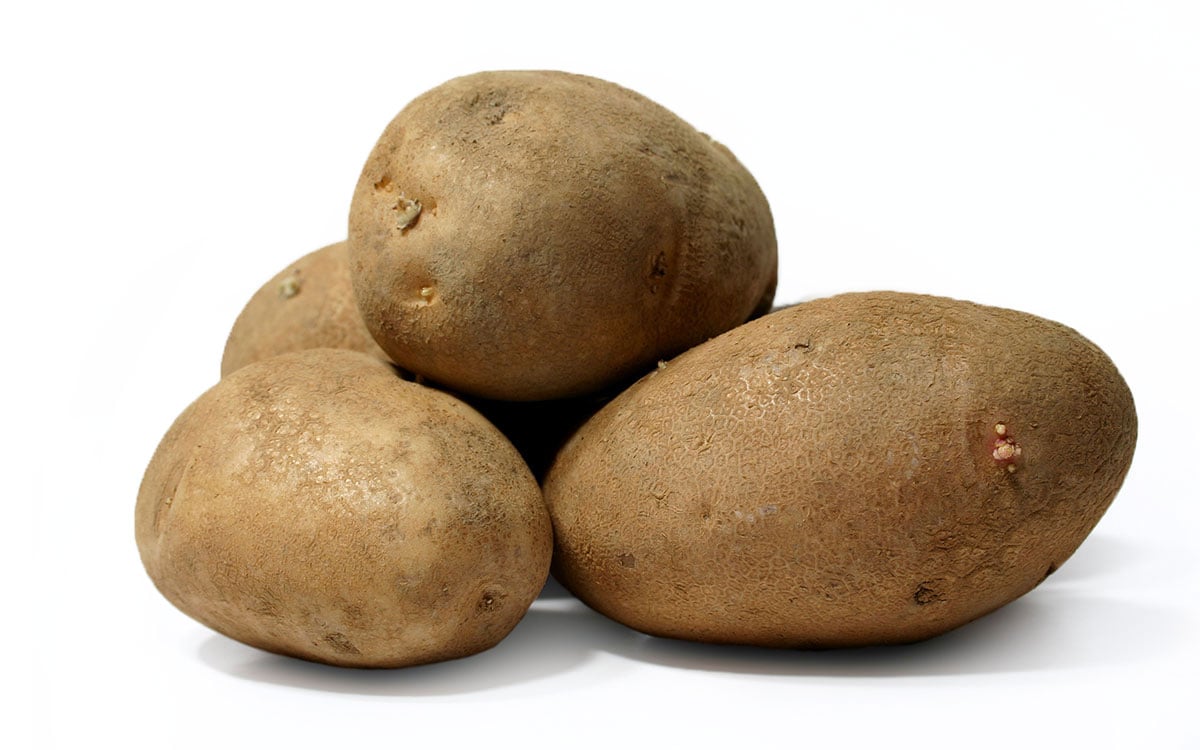
Vitelotte Potatoes
The Vitelotte is a waxy potato brought to Europe from Peru hundreds of years ago. They are produced mostly in France and the United Kingdom, but you can find them at specialty markets in the USA. They are a small spud with a dark purple skin and flesh. They maintain their color when cooked making them good for uses in which you want to showcase their color.
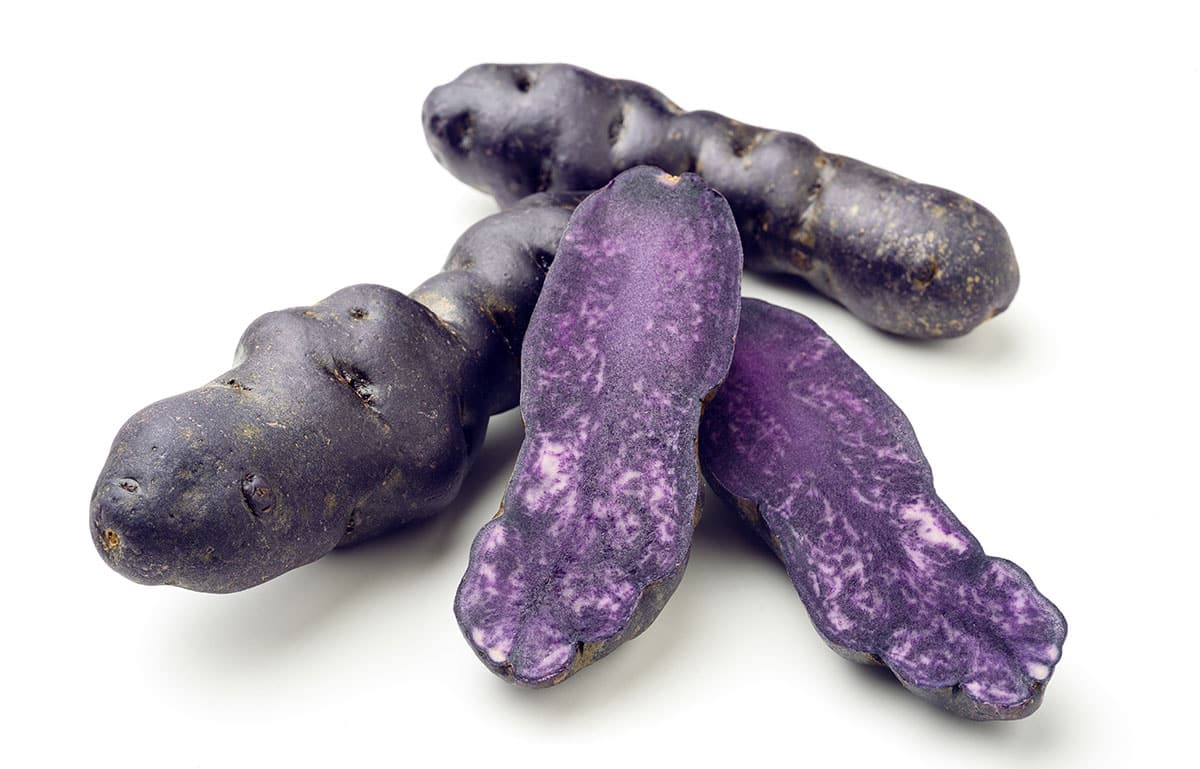
Yukon Gold Potatoes
Yukon Gold is an all-purpose potato popular with many chefs and restaurants for its versatility. They were developed in Canada in the 1960s but not brought to commercial markets until 1980. They make creamy mashed potatoes and don’t need to be peeled before mashing. They are also widely used in potato salads. Yukon Gold’s are a great option to keep in your pantry to support many recipes (like this slow cooker potato soup or breakfast potatoes)!
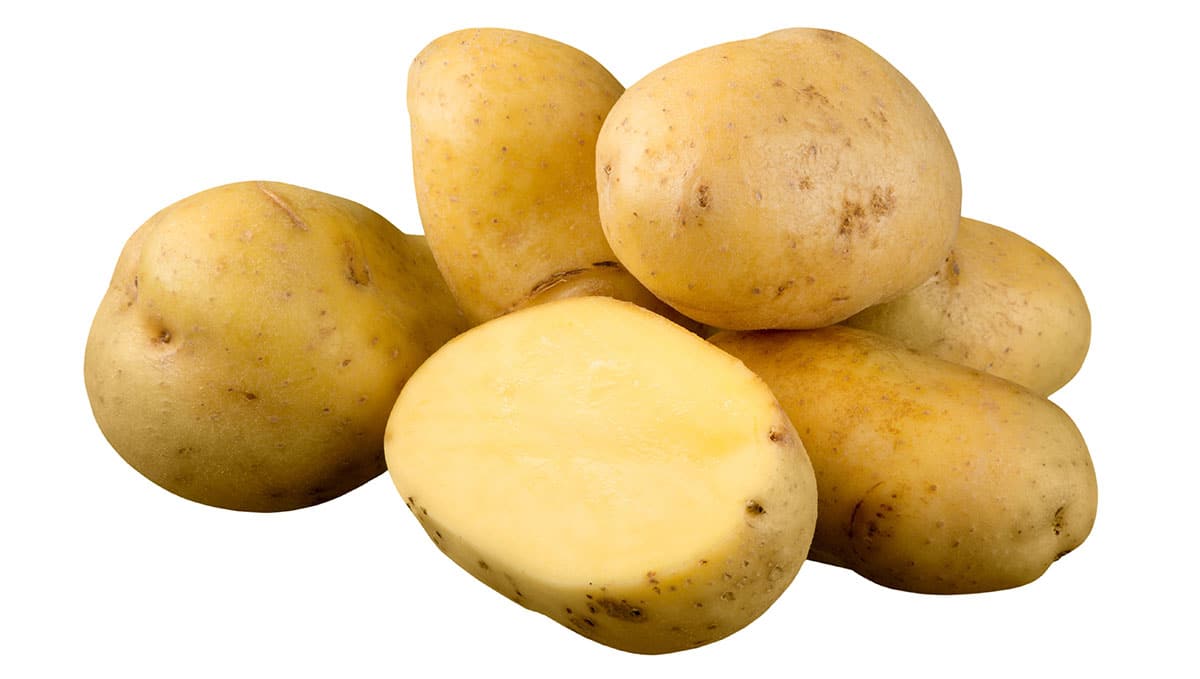
Potato Trivia Answer
Mr. Potato was missing the body! The original idea was for kids to take a potato from the pantry and attach the facial parts.
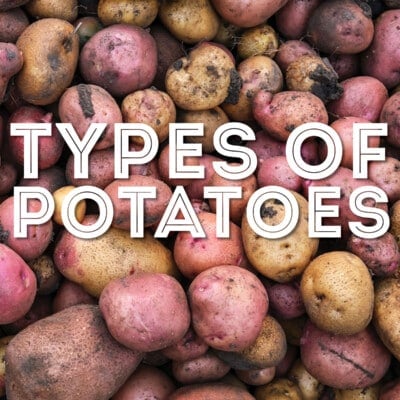
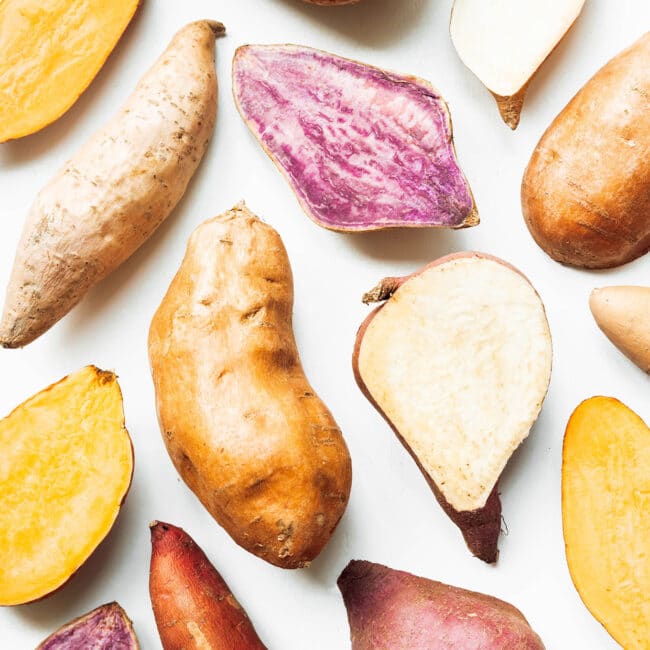

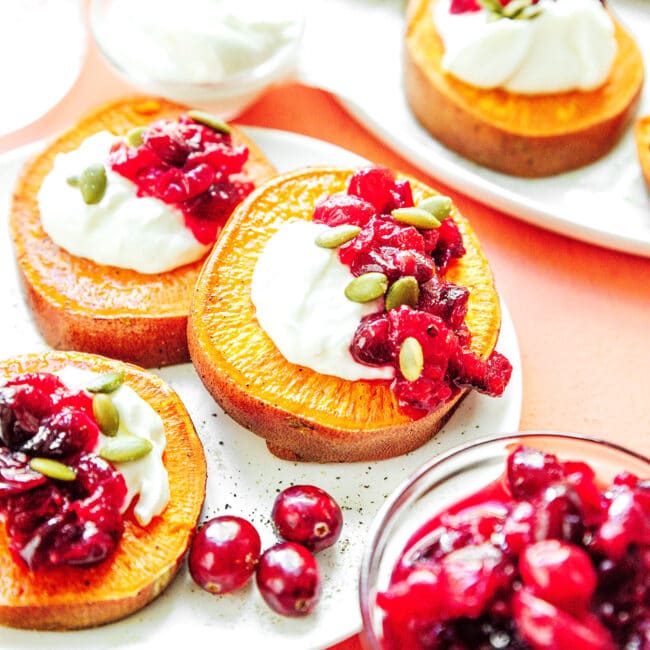
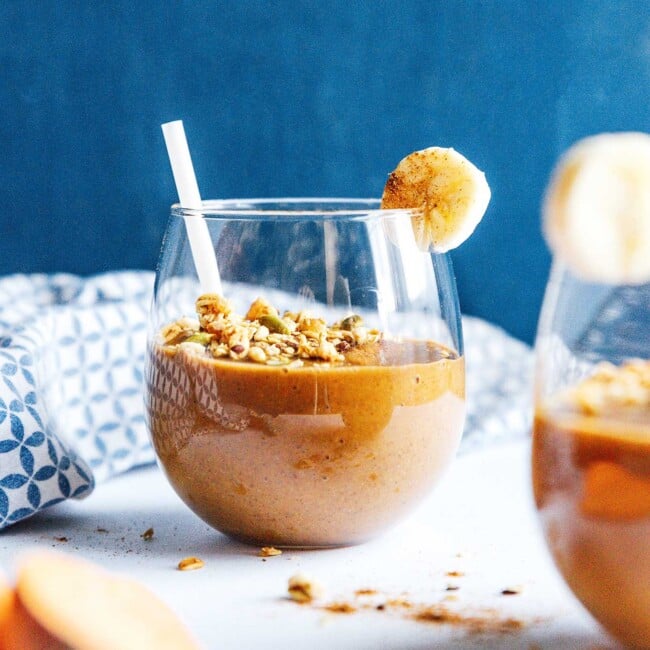
Raymond Moorhouse says
A most delightful and informative, I will pass on to my friends.